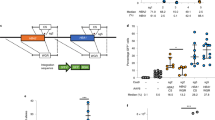Abstract
A 191-kb human bacterial artificial chromosome (BAC) containing the human α-globin genomic locus was used to generate transgenic mice that express, exclusively, human α-globin (huα-globin). Expression of huα-globin reaches a level of 36% of that of endogenous mouse α-globin (muα-globin) on a heterozygous mouse α-thalassemia background (muα-globin knockout, muα+/−). Hemizygous transgenic mice carrying the huα-globin locus on a heterozygous knockout background (huα+/0, muα++/−−) demonstrated complementation of most hematologic parameters. By crossing huα+/0, muα++/−− mice, we were able to generate mice entirely dependent on huα-globin synthesis. Breeding and fluorescent in situ hybridization studies demonstrate that only mice homozygous for the transgene were able to rescue embryonic lethal homozygous muα-globin knockout embryos (muα−−/−−). Adult rescued mice produce hemoglobin at levels similar to wild-type mice, with partial red cell complementation based on mean corpuscular volume (MCV), mean corpuscular hemoglobin (MCH), and red cell distribution width (RDW) measurements. Significant erythrocythemia above wild-type levels seems to be the main compensatory mechanism for the normalization of the hemoglobin levels in the rescued animals. Our studies demonstrate that the huα-globin locus in the 191-kb transgene contains all the necessary elements for the regulated expression of huα-globin in transgenic mice. This animal model should be valuable for studying the mechanisms regulating huα-globin production and for development of therapeutic strategies for β-thalassemia based on downregulation of α-globin expression.



Similar content being viewed by others
References
Al-Hasani K, Vadolas J, Voullaire L, Williamson R, Ioannou P (2004) Complementation of alpha-thalassemia in alpha-globin knockout mice with a 191 kb transgene containing the human alpha-globin locus. Transgenic Res 14: 235-243
Feng DX, Liu DP, Huang Y, Wu L, Li TC, et al. (2001) The expression of human alpha-like globin genes in transgenic mice mediated by bacterial artificial chromosome. Proc Natl Acad Sci U S A 98: 15073-15077
Gourdon G, Sharpe JA, Wells D, Wood WG, Higgs DR (1994) Analysis of a 70 kb segment of DNA containing the human zeta and alpha-globin genes linked to their regulatory element (HS-40) in transgenic mice. Nucleic Acids Res 22: 4139-4147
Hatton CS, Wilkie AO, Drysdale HC, Wood WG, Vickers MA, et al. (1990) Alpha-thalassemia caused by a large (62 kb) deletion upstream of the human alpha globin gene cluster. Blood 76: 221-227
Higgs DR, Vickers MA, Wilkie AO, Pretorius IM, Jarman AP, et al. (1989) A review of the molecular genetics of the human alpha-globin gene cluster. Blood 73: 1081-1104
Higgs DR, Sharpe JA, Wood WG (1998) Understanding alpha globin gene expression: a step towards effective gene therapy. Semin Hematol 35: 93-104
Jamsai D, Zaibak F, Khongnium W, Vadolas J, Voullaire L, et al. (2004) A humanized mouse model for a common beta0-thalassemia mutation. Genomics 85: 453-461
Leder A, Daugherty C, Whitney B, Leder P (1997) Mouse zeta- and alpha-globin genes: embryonic survival, alpha-thalassemia, and genetic background effects. Blood. 90: 1275-1282
Mortlock DP, Guenther C, Kingsley DM (2003) A general approach for identifying distant regulatory elements applied to the Gdf6 gene. Genome Res 13: 2069-2081
Paszty C, Mohandas N, Stevens ME, Loring JF, Liebhaber SA, et al. (1995) Lethal alpha-thalassemia created by gene targeting in mice and its genetic rescue. Nat Genet 11: 33-39
Rund D, Rachmilewitz E (2001) Pathophysiology of alpha- and beta-thalassemia: therapeutic implications. Semin Hematol 38: 343-349
Sarsero JP, Li L, Holloway TP, Voullaire L, Gazeas S, et al. (2004) Human BAC-mediated rescue of the Friedreich ataxia knockout mutation in transgenic mice. Mamm Genome 15: 370-382
Schrier SL (2002) Pathophysiology of thalassemia. Curr Opin Hematol 9: 123-126
Vadolas J, Wardan H, Orford M, Voullaire L, Zaibak F, et al. (2002) Development of sensitive fluorescent assays for embryonic and fetal hemoglobin inducers using the human beta-globin locus in erythropoietic cells. Blood 100: 4209-4216
Vadolas J, Wardan H, Orford M, Williamson R, Ioannou PA (2004) Cellular genomic reporter assays for screening and evaluation of inducers of fetal hemoglobin. Hum Mol Genet 13: 223-233
Vadolas J, Wardan H, Bosmans M, Zaibak F, Jamsai D, et al. (2005) Transgene copy number-dependent rescue of murine beta-globin knockout mice carrying a 183 kb human beta-globin BAC genomic fragment. Biochim Biophys 1728: 150-162
Acknowledgments
JV is a currently a recipient of a Cooley’s Anemia Research Fellowship from the Cooley’s Anemia Foundation, USA. This work was supported by grants from the Brockhoff Foundation and the National Health and Medical Research Council of Australia. The authors thank Dr Kerry Fowler and Ms Sophie Gazeas for support with the animal work.
Author information
Authors and Affiliations
Corresponding author
Additional information
We dedicate this article to the memory of our valued friend and colleague Panayiotis A. Ioannou who passed away during the completion of this work
Rights and permissions
About this article
Cite this article
Al-Hasani, K., Vadolas, J., Knaupp, A.S. et al. A 191-kb genomic fragment containing the human α-globin locus can rescue α-thalassemic mice. Mamm Genome 16, 847–853 (2005). https://doi.org/10.1007/s00335-005-0089-9
Received:
Accepted:
Published:
Issue Date:
DOI: https://doi.org/10.1007/s00335-005-0089-9




